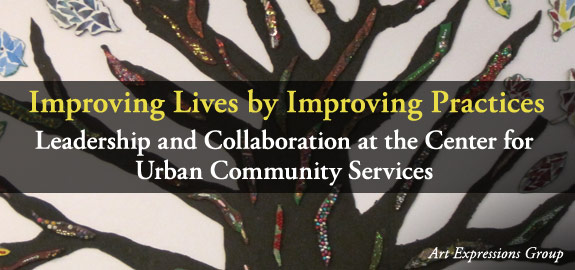In December 2010, New York’s Center for Urban Community Services (CUCS) received the 2010 PATH Exemplary Practice Award for Leadership and Collaboration at the Biennial PATH Grantee Meeting. The award recognizes the agency for making significant improvements in the lives of the people it serves through collaboration with other programs in the community.

The Center for Urban Community Services (CUCS) helps consumers to avoid homelessness in periods of transition. CUCS administers a PATH-funded project known as the Reentry Coordination System (RCS) that was developed with the assistance of the New York State Office of Mental Health. The purpose of the RCS is to manage access to supportive housing units in New York City for individuals released from New York State prisons. These individuals suffer from serious mental illness (SMI) and were either homeless at the time of their incarceration or will experience homelessness upon release. Sue Smith, Director of the CUCS Housing Resource Center, notes that the RCS is instrumental in transitioning individuals into supportive mainstream services.
People who become involved with the RCS find that it works to break down stereotypes about the criminal justice population. Individuals in prison who suffer from serious mental illness may be in prison as a result of criminal actions connected to their mental illness. Imprisonment as a means to impact behavior may not be the way to restore an individual to full health.
The RCS project takes a hands-on approach. The program establishes connections for individuals with serious mental illness who are approaching release from prison. Ms. Smith emphasized that the main objective of this project is to bring this population back into the community in a streamlined way, by connecting housing providers directly with individuals. In order to transition individuals into the community successfully, an understanding of the prison system and impact on the individual is necessary.
The RCS is a success because it translates the services and methods available to assist this population. There are still challenges. Ms. Smith cited obtaining some of the medical information for individuals as a difficult systems issue. The more information the project can obtain, the better the assistance to the individual upon reentry. She acknowledged that the project provided a good systems learning experience for all involved.
The RCS promotes staff involvement and enthusiasm. Ms. Smith commented, “More of our staff want to be in this project than what is needed to run it!” CUCS provides street outreach and works with people who struggle with multiple barriers to housing, including people not accessing any systems of service at all. The agency focuses on increasing understanding of how housing this population within the community can more effectively treat the individuals involved. Ms. Smith mentioned that community providers often latch onto criminal histories and focus too much on that aspect. As a result, this perceived label can diminish or prevent enrollment in services.
Information available to providers about this population can be misinterpreted. For example, a person may be in a maximum security prison because of his mental health needs and the services available there rather than the nature of the conviction. Yet, a housing provider will see that the individual was placed in a maximum security prison on the housing application and assume the person is high risk. Ms. Smith acknowledged that part of the problem is the focus. If the focus shifts to illuminating the fact that these individuals battle serious mental illnesses instead of their criminal histories, it can “open the doors more.”
CUCS is making significant improvements in the lives of the people with whom they work, in spite of the challenges encountered. Ms. Smith commented that more people are housed as soon as they arrive in New York City, “People get housing from the gates of the prisons.” Prior to the RCS, data for housing individuals with serious mental illnesses exiting the New York prison system was minimal. Now, CUCS can track who does obtain housing and follow up with those individuals who do not to provide further assistance.
RCS provides a host of services to assist this transitioning population, including:
· providing consultation to pre-release coordinators to complete housing applications and preparing inmates for housing interviews;
· reviewing and sending applications to housing providers;
· arranging video-conference interviews between the inmate and housing providers;
· linking inmates to needed mental health case management or Assertive Community Treatment (ACT) services in the community;
· providing referrals to outpatient mental health treatment if the inmate does not have one prior to release; and
· tracking referrals and outcomes for inmates.
Matching inmates with a housing provider to meet their needs usually involves the inmate, multiple housing providers, and a pre-release coordinator to manage the connections for transition. In this process, the inmates have the opportunity to represent themselves to the housing providers prior to release. The inmates can interact with multiple housing providers in one interview, eliminating the need for multiple interviews.
On the same token, housing providers are able to maximize their time and resources by scheduling multiple interviews on the same day using video-conferencing services, which saves on costs related to time, transportation, and energy. The use of video-conferencing technology helps to avoid gaps between the time of prison release and the receipt of a supportive housing placement. Focusing on individual consumer services, the project tackles challenges inmates may encounter in obtaining a housing placement. If three housing providers reject an inmate in this process, the staff work with the pre-release coordinator to address the inmate’s challenges to achieve a supportive housing placement.
Ms. Smith believes that other communities could replicate RCS to assist individuals anticipating release from prisons. With training and technical assistance, this project could be very transferrable to other states and territories desiring to streamline connections among systems. Ms. Smith emphasized hope and vision as necessary to support stable transitions.
